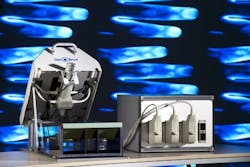Finger scanner uses optoacoustic imaging to detect arthritis early
The Fraunhofer Institute for Biomedical Engineering (IBMT; Saarland, Germany) is leading a project dubbed IACOBUS that is working to develop a finger scanner driven by optoacoustic imaging that will allow arthritis of the hands to be diagnosed at a very early stage.
Related: Fluorescence promises earlier diagnosis, better treatment for osteoarthritis
Chronic arthritis such as rheumatoid arthritis has no cure as of yet, but when caught at an early stage it can be held in check successfully using medication. However, early detection of arthritis requires suitable imaging techniques. Conventional x-ray imaging will only detect typical features of arthritis at a fairly advanced stage. By contrast, use of Doppler ultrasound is more likely to detect arthritis at an earlier stage by visualizing changes in local blood flow. Increased blood flow in the inflamed and thickened synovial membrane is a typical sign of the condition, caused not only by widening of existing blood vessels but also by formation of new blood vessels as a result of the inflammatory process. However, since formation of blood vessels starts off very small with a correspondingly low blood flow, its detection by Doppler ultrasound at an early stage still remains challenging. Magnetic resonance imaging (MRI) can detect arthritic changes of cartilage and bone earlier than x-ray, but is significantly more expensive than x-ray and Doppler ultrasound.
To improve early detection of different types of arthritis, a European consortium composed of several research institutions and companies and led by Fraunhofer IBMT is currently developing an alternative diagnostic technique combining ultrasound technology with novel detection methods. Specifically, this involves the use of a 3D finger scanner that searches joints for sites of inflammation as well as other pathological changes. “One of the advantages of this method is that it enables us to detect the condition while it is still in its early stages, since many forms of arthritis affect the fingers first,” says Dr. Marc Fournelle, IACOBUS project manager at Fraunhofer IBMT.
The scanner operates using an optoacoustic imaging technique, in which the fingers are subjected to extremely short laser light pulses of variable wavelength. As the tissue absorbs these brief light pulses, a minimal amount of warming occurs, which in turn causes the tissue to expand a tiny bit. This expansion then causes slight pressure pulses, which the scanner registers using an acoustic transducer in the same way that ultrasound imaging procedures do. From the pattern of the pressure pulses, the device can pinpoint exactly where inflammation is forming. To refine the diagnosis, the optoacoustic procedure is further enhanced by the use of a hyperspectral imaging system. This method is based on scanning the finger with a strong white light, with the result that light of certain wavelengths is absorbed by the inflamed tissue. By analyzing which wavelengths are found in the light that is not absorbed by the tissue, scientists can determine whether or not the tissue is affected. Given that both of these procedures primarily produce images of soft tissue—blood vessels in particular—the system also provides ultrasound images that are likewise created using the scanner’s acoustic transducer.
“As always, the images produced by ultrasound depict soft tissue such as muscles, tendons, and joint capsules as well as the surface of the bones, which means that our scanner gives physicians a familiar image to work with,” says Fournelle. The ultrasound image is then combined with the data from the hyperspectral imaging and the optoacoustic procedure, enabling doctors to clearly identify any sites of inflammation in the tissue.
The team will be presenting a prototype of the new technology at the MEDICA trade fair in Düsseldorf, Germany, from November 16-19, 2015 (Hall 10, Booth G05).
For more information, please visit www.iacobus-fp7.eu.
Follow us on Twitter, 'like' us on Facebook, connect with us on Google+, and join our group on LinkedIn

